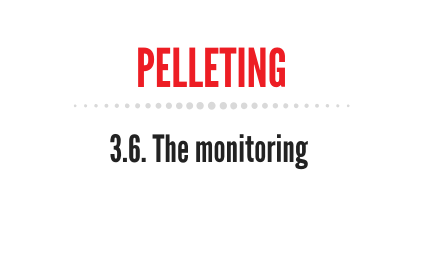The monitoring

Although the pelleting system may be operated manually, most installations are automated for efficiency and consistency of product produced. There are four key points that must be controlled or monitored:
- the flow rate of mash material entering the system;
- the flow rate of steam entering the conditioner;
- the temperature of the mash at the outlet of the conditioner;
- the load on the main pellet mill drive motor.
It is desirable to keep the load on the main mill motor operating at least 85% to 90% of its maximum rated capacity. This load is determined by the amount of product passing through the die and the amount of work done in the die to make the pellet. The work done in the die during the process is not easily adjusted, unless dies are changed or the fluidity of the mash entering the die is adjusted. The rate at which the feeder is delivering mash to the conditioner and die is the adjustment used to control the load on the pellet mill drive motor. Thus, these two things are tied together and controlled by automation.
The second control is monitoring the mash temperature and/or moisture content when it exits from the conditioner before entering the die chamber. This monitoring point is used to determine the required steam flow rate into the conditioner. A motorized modulating flow control valve is installed on the steam system to control the rate of steam delivered to the conditioner. Automated steam control systems also have a power on/off valve in the piping to interrupt the stem flow when the machine stops.